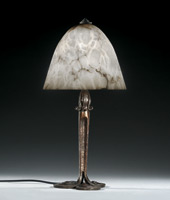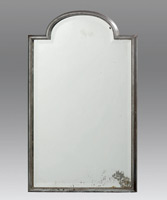| Edgar Brandt - Life and Work
1880
|
|
Edgar Brandt was born in Paris on 24th December at 46, rue de Bergelais, Paris. |
| |
|
|
1886
|
|
Family moved to Orléans. |
| |
|
|
1894
|
|
Enrolled at the Ecole Nationale Professionelle de Vierzon, a technical, craft-orientated
school, only every 5th applicant is accepted. |
| |
|
|
1898
|
|
Left with Diploma on 31st July (Brevet Technicien Supérieur).
Two years‘ military service with the 153rd Infantry in Nancy.
|
| |
|
|
| 1901 |
|
Opening of the first small workshop at 76, rue Michel-Ange, where he already took on
some employees. |
| |
|
|
| 1903 |
|
Took part for the first time in the Salon des Artistes Décorateurs.
In the early years Brandt mainly produced jewellery and silver-smith’s work. |
| |
|
|
| 1904 |
|
Married Renée Largaud (1883-1963) on 16th June.
Exhibited a mahogany dining room at the Salon d’Automne.
|
| |
|
|
| 1905 |
|
Birth of daughter Jane.
Purchase of premises for a studio at 101, Boulevard Murat.
|
| |
|
|
| 1907 |
|
Birth of daughter Andrée.
|
| |
|
|
| 1908 |
|
 Awarded gold medal 1st class, at the Salon des Artistes Francais. Became member of
the vetting team of the organisation. Awarded gold medal 1st class, at the Salon des Artistes Francais. Became member of
the vetting team of the organisation.
Brandt was one of the first to utilise and master the possibilities of autogenous welding
on a large scale, ten years before this technique was taught in colleges.
|
| |
|
|
| 1913 |
|
Work for the large town theatre and the Bank Paul in Nancy.
|
| |
|
|
| 1914 |
|
Constructed banisters for the staircase at the Mollien Wing at the Louvre.
Brandt was ordered to go to Toul near Nancy for military service. There it became
apparent to him that the French Infantry had no light versatile weapon with a long
target-range. At the end of the year he returned to Paris with the order to design and
make a 60mm mortar and the relevant ammunition. |
| |
|
|
| 1915 |
|
Presentation of his fist mortar activated by air pressure on three legs with a high
precision range of 360 metres. During the war years Brandt supplied the French State
with this and other weapons designed by himself. |
| |
|
|
| 1919 |
|
Sohn Francois wird geboren.
Der Architekt Henri Favier baut für Brandt am Boulevard Murat das Firmengebäude im Renaissancestil und erhält dafür den 1. Preis im Architekturwettbewerb der Stadt Paris. Das Gebäude wirkt durch
seine Ausstattung wie ein dauerhafter Ausstellungspavillon für Schmiedekunst. |
| |
|
|
| 1919 |
|
Birth of son Francois.
The architect Henri Favier built a new firm in the Renaissance style for Edgar Brandt at
the Boulevard Murat, for which he received the first prize in the City of Paris Architects‘
Competition. Because of its interior fittins, the building can be perceived as a permanent
exhibition pavilion for wrought-iron work.
Took part in the Salon des Artistes Décorateurs and the Salon d‘Automne. From then on
Brandt again exhibited regularly in both Salons. The workshop was equipped with the
latest machinery – lathes, drill benches, punching machines, compressed air hammers,
autogenous and arc-welding equipment. But above all, the principle of division of labour
that he derived from the car industry for the production of luxury works of art was an
innovative approach. In separate workshops, parts were made, assembled and finally
surface-treated and finished. |
| |
|
|
| 1920 |
|
Production of stair-case railings and balustrade grilles for the ocean steamer Paris.
Step-by-step perfection of the workshop in all technical, artistic, logistic and economic
aspects, so that in the mid-‘twenties in France he was virtually without competitors; two
competent business executives played a great role in this success: Henri Favier as Artistic Manager and Eugène Grisard as Head of Finance.
Inauguration of a War Memorial in Verdun, incorporating a gate by Brandt. |
| |
|
|
| 1921 |
|
Sales prices: Lamp Minister approx. FF 650,-. Door with vine motif approx. FF 7.600,-.
The monthly income of a well-paid craftsman was approx. FF 1.500,-. As can be seen
from the price examples, objects signed E. BRANDT were predominantly luxury goods
made by hand. As all wrought iron pieces were made individually and according to the
requirements of the client, they can justifiably be called unique. Even the same pieces
display differences in execution. Amongst the highly qualified employees were to be found
the best graduates of the School for Applied Arts, Ecole Boulle, as well as specially
trained smiths from Hungary.
Awarded title of Knight of the Legion of Honour. |
| |
|
|
| 1922 |
|
Sales price: Door panel The Storks FF 40.000,-.
Gordon Selfridge, London, ordered grilles with the design of The Storks for the lifts in his
department store. These were made of steel sheet and wrought iron, bronzed and
mounted on plywood to save on costs. |
| |
|
|
| 1923 |
|
Awarded the Medal of Honour for Applied Art by the Société des Artistes Francais.
Order for the delivery of stair-case railings, balcony grilles and domed roof for the
department store Au Bon Marché in Paris and Algiers.
Production of the metal surround for the eternal flame at the Tomb of the Unknown
Warrior under the Arc de Triomphe.
Sales price: Entrance portal The Golden Age FF 120.000,-. |
| |
|
|
| 1924 |
|
 Orders for wrought-iron work for the Court and Ministry of Trade in Montreal. Orders for wrought-iron work for the Court and Ministry of Trade in Montreal.
Sales prices: Radiator grille Pinecones approx. FF 2.100,-. Screen Oasis FF 84.000,-
Delivery of 50 tonnes of wrought-iron work to the Silk Manufacturers Cheney Brothers in New York, including doors, mirrors, display cabinets, window frames and external
cladding. The firm’s management was so enthusiastic about Brandt’s designs that it
adapted a number of motifs for their spring silk collection in 1925. |
| |
|
|
| 1925 |
|
Opening of the Gallery Edgar Brandt at 27, Boulevard Malesherbes and of a second
work-shop at 25, rue de Hameau.
In the gallery, the entire spectrum of Art Déco could be seen. There were works on show
in special exhibitions as well as those on permanent display by artists such as Bastard
(ivory and mother-of-pearl work), Bernard, Blondat, Despiau, Pompon, Sandoz
(sculpture), Chabert-Dupont (lace), Daum, Décorchement, Lalique, Luce (glass), Decoeur,
Heiligenstein, Sèvres (ceramics), DIM, Jallot, Leleu, Ruhlmann, Sue & Mare, Jourdain
(furniture), Dunand (metal and lacquer work), Jaulmes, de Warouier (paintings), Jensen,
Puiforcat (silver), Kieffer (book-binding) and da Silva Bruhns (carpets).
Opening of offices in London and New York under the name Ferrobrandt.
Sales prices: Table lamp Cobra approx. FF 700,-/800,-, fire-screen Dancer FF 3.700,-,
console Acanthus approx. FF 4.500,-, doors Cockades FF 11.500,-.
Paul Poiret opened his Fashion House – entrance door and staircase railings by Brandt.
In April the Exposition des Arts décoratifs et Industriels modernes began, where Edgar
Brandt was able to display the entire spectrum of his work. He designed the main
entrance portal – the Porte d’Honneur and his own octagonal stand, which were both
greatly admired. In addition, he provided different types of wrought-iron work for the
pavilions of Ruhlmann, Studium Louvre, Sèvres Porcelain, Monaco and Max furs as well as
for the French Embassy and the newspapers L’Intransigeant and L’Illustration.
It was only because of his permanent presence at the Exposition that Brandt received
international acclaim. |
| |
|
|
| 1926 |
|
Official founding of the Societé des Etablissements Brandt on 9th April. From this point
on there was a clear distincion between the production of works of art and the
manufacture of arms. The latter received his renewed attention.
Awarded the title of Officer of the Legion of Honour. |
| |
|
|
| 1927 |
|
The Artistic Director Henri Favier and one of the best young designers, Gilbert Poillerat,
left the firm.
On the occasion of the annual exhibition of the Artistes animaliers, a small group of
animal sculptors, Brandt also exhibited small objects in the gallery such as paperweights,
book-ends and ashtrays with animal designs.
Unveiling of another War Memorial by Brandt near Compiègne.
Eugène Grisard was replaced by Brandt’s son-in-law Pierre Renaud as Head of Finance,
but was still employed until 1934.
Signing of a contract with the State for the production of a 81mm mortar developed by
Brandt, which was exported to 52 countries up until 1939.
Ferrobrandt in New York closed. |
| |
|
|
| 1928 |
|
Production of wrought-iron work for St. John the Baptist’s Church in Pawtucket, Rhode
Island.
Edgar Brandt followed the change in taste and created geometric forms using modern
metals like aluminium and chromed steel. |
| |
|
|
| 1930 |
|
Manufacture of two entrance doors for the Colonial Museum in Paris with elephant motifs
after designs by the painter Paul Jouve, later shown at the Salon d’Automne. |
| |
|
|
| 1932 |
|
After four years of planning and construction the firm moved to new premises in
Châtillon-sous-Bagneux, near Paris. Some 1000 people were employed there and there
were 2000 machines. Specifically the manufacture of arms was organized following
modern production methods, using conveyor belts and teamwork. The administration
buildings were modern and spacious and were fitted with expensive furnishings of the
highest quality, designed by Brandt himself.
Wrought-iron work for War Memorial in Turckheim, Alsace.
In collaboration with Georges Bastard Brandt designed place settings and table
decorations for the ocean steamer Normandie.
Together with the already established perfect organisation, the new factory in Châtillon
made it possible to execute large orders in the shortest time such as the work for the
National Theatre in Mexico, worth FF 4.000.000,--, which took only three months.
An advertisement put the value of the capital of the company at FF 15.700.000,--.
Opening of offices at 52, Avenue des Champs-Elysées.
The Gallery Edgar Brandt was closed, as it was no longer profitable.
Wrought-iron decoration for a large cinema on the Chaps-Elysées. Wrought-iron work
was still in demand for public and representative buildings. |
| |
|
|
| 1936 |
|
Take-over of arms manufacture in Châtillon by the Socialist Government. |
| |
|
|
| 1937 |
|
Entrance door for the Town Hall in Vincennes. |
| |
|
|
| 1939 |
|
Journey to USA and Canada with his wife and son on the Normandie. |
| |
|
|
| 1942 |
|
Moved to Switzerland. |
| |
|
|
| 1955 |
|
Given an order to restore six monumental doors in the Palace of Versailles. |
| |
|
|
| 1960 |
|
Edgar Brandt died in Geneva after a long illness. |
| |
|
|
| |
|
back |
| |
|
|
|